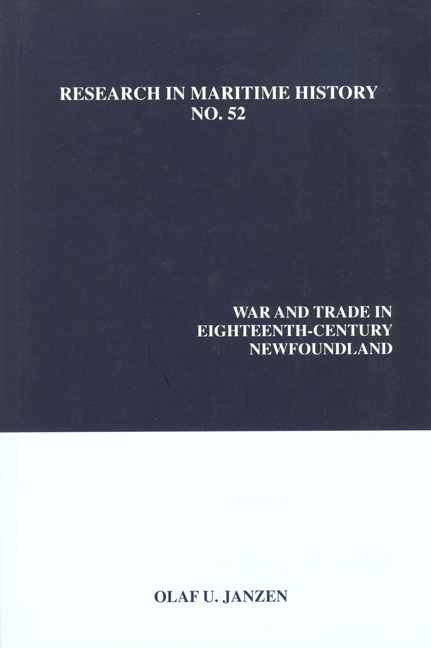Book contents
- Frontmatter
- Table of Contents
- About the Author
- Introduction
- “‘A World Embracing Sea:’ The Oceans as Highway, 1604-1815”
- “Of Consequence to the Service:' The Rationale behind Cartographic Surveys in Early Eighteenth-Century Newfoundland”
- “The Problem of Piracy in the Newfoundland Fishery in the Aftermath of the War of the Spanish Succession”
- “A Scottish Sack Ship in the Newfoundland Trade, 1726-1727”
- “'Une petite Republique' in Southwestern Newfoundland: The Limits of Imperial Authority in a Remote Maritime Environment”
- “The Illicit Trade in English Cod into Spain, 1739-1748”
- “Un Petit Dérangement: The Eviction of French Fishermen from Newfoundland in 1755”
- “The French Raid upon the Newfoundland Fishery in 1762: A Study in the Nature and Limits of Eighteenth-Century Sea Power”
- “Showing the Flag: Hugh Palliser in Western Newfoundland, 1763-1766”
- “The Royal Navy and the Interdiction of Aboriginal Migration to Newfoundland, 1763-1766”
- “The Royal Navy and the Defence of Newfoundland during the American Revolution”
- “The American Threat to the Newfoundland Fisheries, 1776-1777”
- Appendix
“A Scottish Sack Ship in the Newfoundland Trade, 1726-1727”
- Frontmatter
- Table of Contents
- About the Author
- Introduction
- “‘A World Embracing Sea:’ The Oceans as Highway, 1604-1815”
- “Of Consequence to the Service:' The Rationale behind Cartographic Surveys in Early Eighteenth-Century Newfoundland”
- “The Problem of Piracy in the Newfoundland Fishery in the Aftermath of the War of the Spanish Succession”
- “A Scottish Sack Ship in the Newfoundland Trade, 1726-1727”
- “'Une petite Republique' in Southwestern Newfoundland: The Limits of Imperial Authority in a Remote Maritime Environment”
- “The Illicit Trade in English Cod into Spain, 1739-1748”
- “Un Petit Dérangement: The Eviction of French Fishermen from Newfoundland in 1755”
- “The French Raid upon the Newfoundland Fishery in 1762: A Study in the Nature and Limits of Eighteenth-Century Sea Power”
- “Showing the Flag: Hugh Palliser in Western Newfoundland, 1763-1766”
- “The Royal Navy and the Interdiction of Aboriginal Migration to Newfoundland, 1763-1766”
- “The Royal Navy and the Defence of Newfoundland during the American Revolution”
- “The American Threat to the Newfoundland Fisheries, 1776-1777”
- Appendix
Summary
Early in the morning of 30 July 1726, the ship Christian, Captain Alexander Hutton, passed through the Narrows into the harbour of St. John's, Newfoundland. In its hold were thirty-two casks holding five tons of “Bisquett.” As well, the vessel carried a substantial quantity of fabrics, clothing, shoes and a variety of sundry goods ranging from inkhorns to buckles and buttons to thimbles and pins. The investors who had chartered Christian had directed the ship to “St Johns, Ferryland, or the Bay of Bulls, or any Harbour thereabouts,” where the master and supercargo were instructed to sell the biscuit “to the best advantage, rather to Masters of Ships, than to the fishermen upon the Island.” They were then to acquire “where you best can” a cargo of “good Merchantable fish, well dryed & fair to the eye,” without “Spots or blemishes,” for subsequent delivery to Barcelona, Spain. There the investors’ agent would arrange for the sale of the fish and the acquisition of a partial cargo of cork before Christian began the homeward journey. The ship would stop only at Sanlúcar, north of Cádiz, to complete its cargo with sherry and fruit. The voyage was not without its share of uncertainties. It might not find fish in Newfoundland to complete its cargo; it might find itself caught by the outbreak of the war that was then threatening between England and Spain; it might find itself a victim of piracy; it might not be able to pick up a cargo in southern Europe. The investors’ instructions were therefore quite specific on how to proceed in these eventualities. They knew that once at sea Christian was outside their control, and the success of their investment depended entirely upon the judgment and ability of the men they had placed in its charge.
In its purpose, its cargo and its route, Christian was what was commonly called in the Newfoundland trade a “sack ship,” one of at least fifty-five such ships reported in Newfoundland that year. What set this particular voyage and its investors apart from the others was that Christian was from Leith, the port community serving the Scottish city of Edinburgh. Most sack ships were English, usually based in London or the West Country; recently, a few Irish ships had also ventured into the trade. A Scottish presence, however, was almost unprecedented.
- Type
- Chapter
- Information
- War and Trade in Eighteenth-Century Newfoundland , pp. 49 - 68Publisher: Liverpool University PressPrint publication year: 2013



